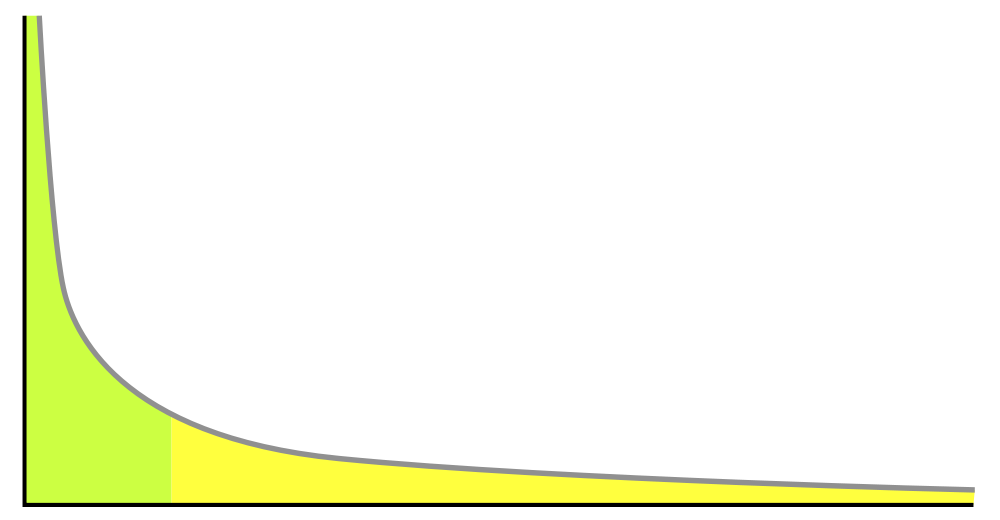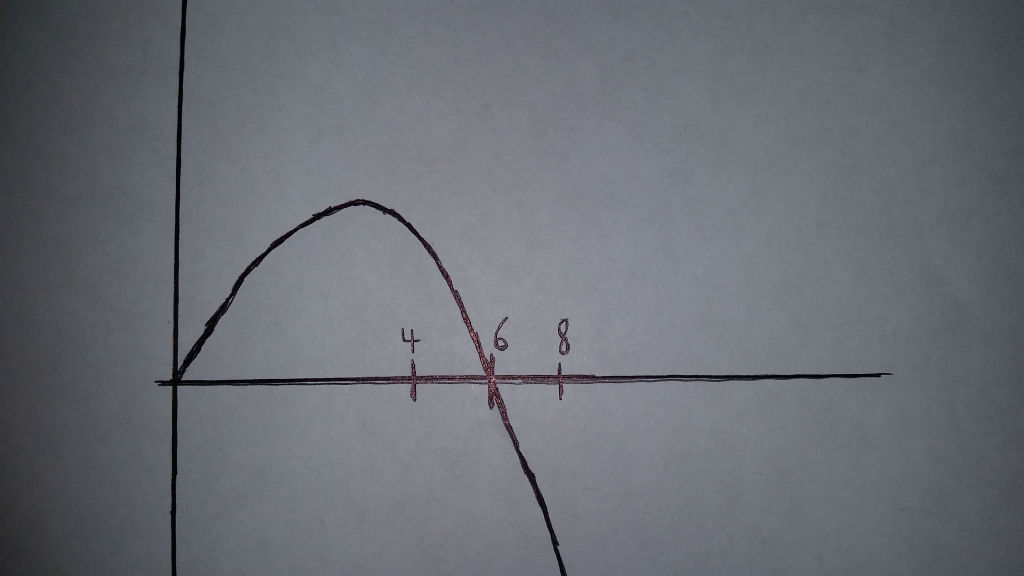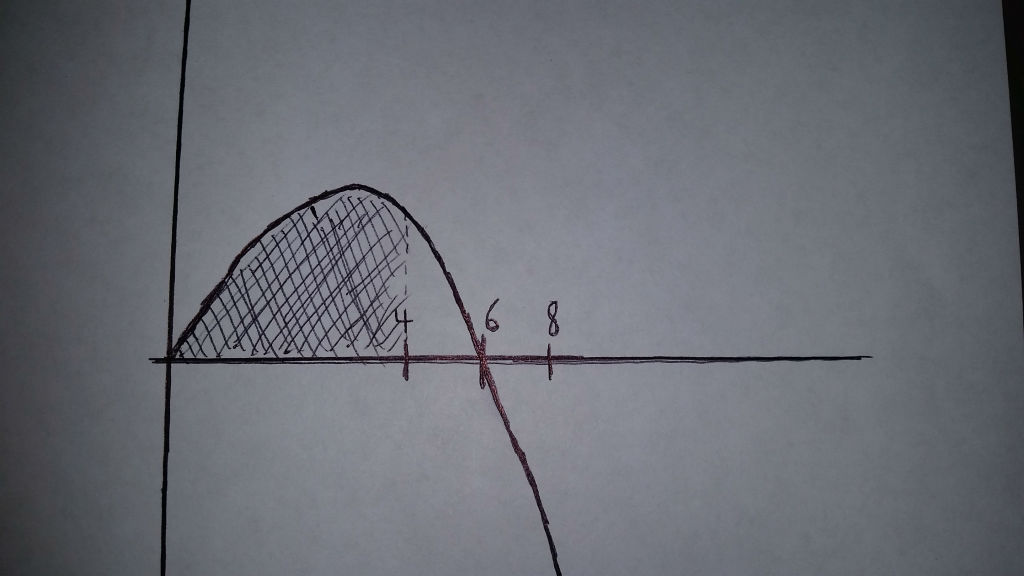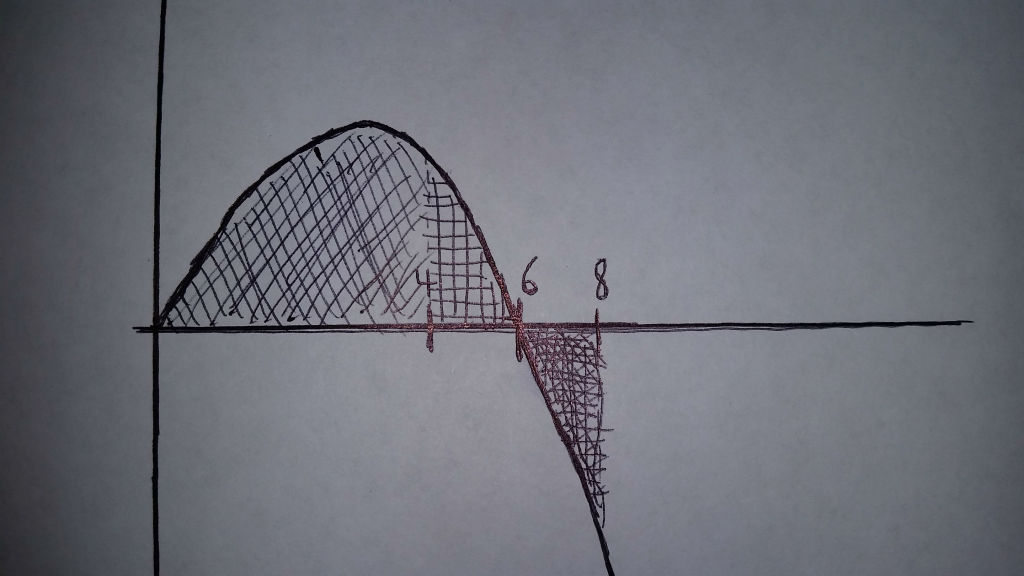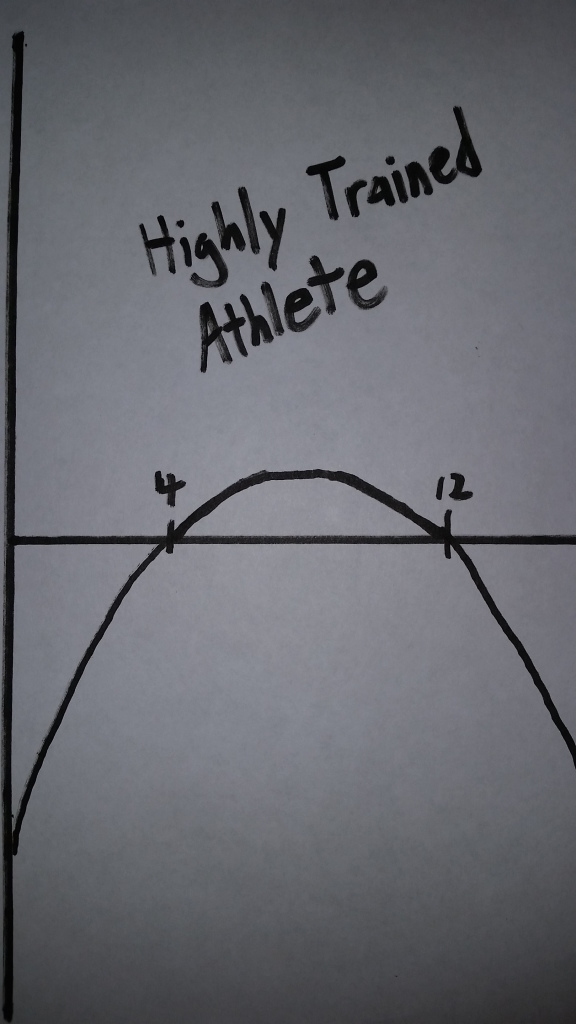For those of you who want to know the “why” behind the “what” today’s post is for you. Don’t let the math part scare you; the lessons listed below really are quite simple. With that I’ll let author Greg Nuckols take over from here. Hope you enjoy! – Nate
What you’re getting yourself into:
~3400 words.
10-15 minute read time.
Key points
1) Having useful conceptual frameworks can help you reason through problems as they arise, rather than having to invest a ton of time to seek out each individual answer. This is especially useful if you need to make decisions on the fly or if you’re really busy.
2) Factors that fall under the umbrella of “recovery” tend to follow a power law distribution – you get the most bang for your buck from initial increases, with further increases making less and less of a difference.
3) Factors that fall under the umbrella of “stressors” tend to follow a parabolic distribution – more is better, until you overwhelm your body’s ability to adapt.
4) “Recovery” factors, and things such as training status, drugs, and genetics can shift the stress curve, increasing or decreasing the amount of stress you can handle.
This article isn’t anything groundbreaking. For half of you, you’ll probably read along thinking “I’d had similar thoughts before, but I wasn’t quite sure how to express it.” For the other half, you’ll read along thinking, “I already know this, but it’s nice to have all of this in one place so I can link it and save myself the typing when I see one of these arguments on Facebook or in a forum somewhere.”
Of late, it’s come into vogue to attack just about every piece of practical gym wisdom, decrying it as “broscience,” with the implication being that if it’s “broscience,” it’s automatically ineffective. Now, I’m all for science (look at the site’s name or the linked article, for example), but I think people are taking things a step too far.
Just because something doesn’t have 15 pubmed links supporting it, that doesn’t necessarily mean it’s ineffective. It could just mean that it hasn’t been directly studied, studied in a relevant population (i.e. not on untrained participants), studied with a relevant training protocol (i.e. not one of the all-too-common study designs that look approximately 0% like how people ACTUALLY train), or studied with large enough groups to find significance (i.e. if something improves gainz by 5-10%, that may be relevant to us, but the difference probably won’t meet statistical significance if there are 10-12 people in each study group).
Furthermore, extrapolating practice from study results is always necessary, unless you or the people you’re training are exactly like the study participants (actually the “average” participant, as if that even exists), and your training/diet protocol exactly mirrors the protocol used in the study.
Because of this, it’s certainly useful to start with the science, but the end goal should be to extract principles that are generalizable to a broader array of circumstances and applications, and to develop heuristics to guide decision making rather than trying to find a discrete study to support everything.
That’s what this article is about – two heuristics that can help guide your training and diet choices:
1) The power law distribution of non-stressful inputs
2) The parabola of stressful inputs
The Power Law Distribution of Non-Stressful Inputs
The basic idea behind a power law distribution is that the majority of your results come from a small number of your inputs, and that further inputs may improve results, but not substantially. You may also recognize this as the Pareto Principle, or the Law of Diminishing Returns.
This is the type of distribution that usually applies to non-stressful inputs to training (usually things that are lumped into the overall category of “recovery.”)
For these things, each increase initially yields a large increase in results, but each subsequent input helps a little bit less than the prior one, to the point that eventually the difference is effectively meaningless.
Four examples: Meal frequency, post workout nutrition, sleep, and training frequency
Meal Frequency
As a reactionary position to the gospel of “6 meals per day to stoke metabolism,” people have taken to saying “meal frequency doesn’t matter.”
Let’s think about that for a moment. The most extreme interpretation of this statement would have you believe that eating 1 meal per week will give you equivalent results to eating 3 meals per day. I hope we can dismiss that as ludicrous at face value. Total caloric intake is certainly the most important factor for diet success, but it’s certainly not everything.
Eating 1 meal per day is going to clearly be substantially better than eating 1 meal per week, even if total caloric intake is the same.
Eating 3 meals per day is going to be noticeably better than eating 1 meal per day (specifically eating protein spread throughout the day instead of all at once).
From there, though, you’re probably reaching a point of diminishing returns. Would 6 meals be better than 3? That’s a little hazy. The evidence on untrained populations indicates that it’s probably not going to make much of a difference, but for more highly trained people, there may be a noticeable effect (scroll down to “Athletic Populations” here).
How about 10 meals per day vs. 6 meals per day? Probably won’t make enough difference to worry about. At that point, you’re on the long tail of the power law distribution – the initial increases account for the majority of the results, while subsequent increases matter less and less.
Note from Nate: I have had clients lose a ton of weight (70+ lbs) while only eating 2 or 3 times per day. They worked in the emergency room of a hospital and the 6 meals a day plan just was NOT an option. Heck, even I have time eating a perfect 6 meals of equal portions throughout the day as I can train 8 or 9 appointments in a row with no break in between. Point is – don’t get bogged down on the small stuff and start making excuses. Just focus on the “big rocks”, total calories and macro-nutrient composition, and you are going to do just fine.
Training Frequency
It’s also been popular lately to espouse high training frequency, especially for drug-free lifters. The idea is that each session causes an elevation in protein synthesis, so you get more “growth cycles” per muscle in the training week. You also get more opportunities to practice a motor pattern, so you master a movement faster.
It’s certainly an idea with some merit behind it.
If you read this site frequently, you’ve probably seen the previous article about how theNorwegian powerlifting team got noticeably better results from doubling the training frequency.
This general trend is seen elsewhere in research. Strength gains tend to be a little better with higher frequency training, and hypertrophy gains seem to favor somewhat higher frequency as well, at least in trained subjects.
However, the same power law distribution still applies. Once per week per muscle or movement will be a lot better than once per month. Twice per week will probably be noticeably better than once per week. However, with each further increase, the magnitude of difference decreases. For most people, the difference between 2 and 3 times per week will be small, and the difference between 3 and 4 will be minimal.
Note from Nate: I find that best results come with 2-3 times per week strength training. This frequency allows for adequate stress and recovery from that stress. More than that, for a novice, usually doesn’t make much of a difference in the grand scheme of things. They would be better served spending that time preparing meals for the week.
Postworkout Nutrition
Ever since Alan Aragon, Brad Schoenfeld, and James Kreiger’s meta-analysis about post workout nutrition was published last year, people have been crying “broscience” left and right at any mention of post-workout nutrition/supplementation.
However, although eating immediately after a workout in the mythical “anabolic window” may not be a make-or-break factor in your training, it’s not a concept to discard completely.
For starters, you’re going to be eating post-workout at SOME point (unless the meal prior to your workout is the last meal you’re going to eat before you starve to death), so at a certain level, the prior discussion of meal frequency applies here.
Secondly, it seems to be related to how much protein you ingest post-workout. 20-40g of protein post-workout seems to be enough to maximize protein synthesis for most people (At least 20g for young folks, and 40g for people 40+, due to “anabolic resistance”) with further increases not having a huge effect.
How soon after you workout you should ingest protein is the more contentious factor. And for this, training status seems to play a role. A recent study found that a post workout protein and carb shake, taken immediately after training, led to significantly better nitrogen retention in highly trained athletes, but not rookies .
It’s also worth pointing out that in the recent meta-analysis, only two of the studies examined were done on well-trained subjects. Of those, one (Hoffman, 2009) showed no significant difference (protein alone pre and post workout, rather than first thing in the morning and last thing at night), and one (Cribb, 2006) showed a significant difference (protein, carbs, and creatine taken immediate pre and post workout, rather than first thing in the morning and last thing at night).
So for this, it seems like the curve is shifted to the right with training. For new lifters, simply getting adequate calories and protein throughout the day encompasses essentially all of the benefits, whereas for more experienced lifters, the point of diminishing returns is reached later, with pre and post workout supplementation having a more noticeable effect.
The general principle still applies – the difference between getting some post-workout nutrition immediately after your workout and 20 minutes after your workout is probably negligible, and the difference between 40g of protein and 80g of protein in that window is probably negligible, but benefits still accrue, to a point, by consuming adequate protein and carbs around your workout, with the benefits diminishing as you consume less, or as the consumption drifts farther from the pre and post workout window.
Sleep
Obviously the most important hours of sleep are your first few hours of sleep. Though it’s certainly not pleasant, you can survive on just a couple hours of sleep per day. Obviously you can’t make gainz if you’re not alive, so the first few hours of sleep (input) give you the most pronounced “results” – simply staying alive.
Past that point, further benefits accrue by getting a full night of sleep. I’ve written about this previously, but getting 7.5 hours of sleep instead of 5.5 hours of sleep can have a substantial impact on your ability to lose fat and gain muscle.
However, there’s also evidence that sleeping too much can be harmful to your health. People who sleep 9 hours or more per night are at an increased risk of developing diabetes than their 7-8 hour per night counterparts, though it’s probably not a direct cause, but rather an indicator of some other underlying problem (i.e. if you regularly NEED to sleep or CAN sleep more than 9 hours per night, it may be because of some other issue that puts you at an increased risk of diabetes). Apart from that, I’m unaware of any evidence that forcing yourself to sleep more than your body demands is beneficial for health or body composition.
So sleep follows a power law distribution as well, with the largest benefits occurring initially (staying alive), and further benefits accruing as you sleep more, to the point of the 7-8 hours your body requires, after which point it won’t make much difference.
There are obviously other factors that fall under the umbrella of “recovery” as well. These are just a few examples to illustrate the point.
When you’re thinking about factors such as these, even if you don’t have the time to keep up with all the scientific literature (which is darn near impossible, especially if it’s not basically your full-time job), you can just adopt this mental framework for thinking about such factors. The largest benefits occur initially, with further benefits accruing with increased inputs until you get to a point that further increases won’t make much of a difference.
Note from Nate: “THE LARGEST BENEFITS OCCUR INITIALLY, with further benefits accruing with increased inputs until you get to a point that further increases won’t make much of a difference”. What a great line. This is why simply getting started can be so important for folks. A little bit can make a HAYUUUGE difference. Just get started and you can literally begin changing your life…..and if you don’t know where to start? Then get a coach.
The Parabola of Stressful Inputs
When thinking about stress, it’s always useful to start with the General Adaptation Syndrome in mind (This article is a good primer). Very small amounts of stress won’t provoke a very robust adaptive response, more stress increases adaptation, but too much stress – to the point that you can’t cope with it physically or psychologically – also decreases the rate of adaptation.
The easiest way to visualize this concept is by looking at the integral of a downward-facing parabola with intercepts at 0 (for an untrained lifter – more on that later) and some arbitrary positive number.
Bet you didn’t come to a lifting blog expecting a spot of calculus. Well, it’s happening. But don’t worry, this is easy to understand.
Here’s one such parabola sketched out, with intercepts at 0 units of stress (no stress means no adaptation) and 6 units of stress (the maximal amount you can handle without reaching beyond your ability to cope).
Here I’ve sketched out the integral (area under the curve) when the body is presented with 4 units of stress. This would be a moderate stressor. The magnitude of adaptation is represented by the shaded area.
Here is the integral for 6 units of stress. As you can see, the shaded area is larger than it was for just 4 units of stress. This means a larger adaptive response. This would represent the maximal amount of stress the body can respond to productively, and the maximal amount of benefit you could possibly get from training.
This represents a stressor larger than that which the body would respond maximally too. Area in quadrant 4 (below the x-axis) represents a reduction in the magnitude of the adaptive response. In this case, since the area between 6 and 8 is roughly equal to the area between 4 and 6, the extra work “negated” some of the benefits that would have been seen from stopping at 6 units of stress, making the net gainz from 4 units of stress and 8 units of stress roughly equivalent.
This is roughly what occurs when dealing with training factors that add stress.
So just to sum all of this up, in case you’re still a little confused about what exactly you’re looking at:
1) the x-intercept on the left (0, for the graphs above) represents the minimum amount of stressnecessary to start having a positive effect.
2) the x-intercept on the right (6, for the graphs above) represents the maximum amount of stress the body can respond productively to.
3) the positive area under the curve, minus the negative area under the curve, is the total amount of gainz you get from your training.
4) the curve itself represents marginal gains or losses as the stimulus increases.
Note from Nate: So all that graphing was basically explaining the “law of diminishing returns”. Imagine that you just finished up a 5K walk/run in the middle of a Texas summer. You would be dying of thirst so after the event you would have a glass of water. This glass of water would be amazing and work to help quench your thirst. You then decide to drink a 2nd, 3rd, and 4th glass of water. Each glass serves to quench your thirst but not as much as the first sip of that first glass. Eventually by glass #16 you and you are not thirsty. Each additional glass of water from here on out would actually serve to begin drowning you and have a negative effect on your thirst… Same thing with training frequency and volume. That is why sometimes as a coach I am not merely there to “kick my clients ass” – I actually need to tell them to slow down; and have some patience. We will reach the goal in due time.
Three examples here: Training volume, training intensity, and cardio training
Training volume
James Kreiger’s wonderful meta-analysis about the effects of doing more sets in training illustrates the first part of this concept beautifully. 2-3 work sets will give you significantly better gains than 1 work set, and 4-6 sets will probably give you better gains than 2-3 sets (it didn’t reach statistical significance, but there is a larger effect size). However, there was a much larger difference between 1 and 2-3 than there was between 2-3 and 4-6. The former would represent going from maybe 2 units of stress in the graphs above, to 4 units of stress. The latter would represent going from 4 to 6 units of stress – increased strength gains, but not nearly to the same extent.
To this point, it’s sounding like a power law distribution again. However, the difference occurs when you continue increasing the magnitude of the stressor.
This is a direct message to anyone who says overtraining doesn’t exist: run a marathon every day, lift weights HARD for 4-5 hours every day, eat as much as you want, sleep as much as you want (and shoot, take whatever steroids you want), and tell me at the end of 6 months if you still think overtraining is imaginary (if you survive until the end).
That represents the curve dipping below the X axis, and the detriments of the stress in excess of the maximal amount you’re capable of adapting to overwhelming the benefits you’d have seen from lower levels of stress.
With training volume, more is better until you reach your limit, at which point further increases don’t just failed to produce better results (as we saw with non-stressful, “recovery”-related things like meal frequency and sleep), but instead lead to worse results.
Note from Nate: All of the “stressors” such as volume and frequency of training also vary client from client. This is no 1 right answer for everyone; merely guidelines. This is why it can be helpful to have a coach is not only educated but also has some time in the field and knows when to venture away from the playbook so to speak. How to realize the difference between “over-training” and “over-reaching” in order to help maximize that clients time and effort while simultaneously reducing the chance of injury.
Training Intensity
Training intensity is similar to training volume. Research has shown that using loads of at least 60% of your max are necessary to cause robust gains in hypertrophy under non-hypoxic conditions (i.e. we’re not discussing blood flow restriction here). From that point, there’s a range from about 60-85% that gives you the most bang for your buck in terms of strength and hypertrophy gains.
When you start training above 85% regularly, especially if you’re taking a lot of your sets close to failure, the benefits start decreasing. This is because training volume is priority #1, and you simply can’t handle very much training volume with 90-100% of your max. Training that heavy has its place when peaking for a meet, but doesn’t allow you to simply do enough work to make your best strength and size gains year-round under most circumstances.
I have a really long explanation for why this is (based more on the psychological stress of training super heavy, super close to failure all the time, and how strength gains are limited by muscle size in the long run), but since this isn’t going to be a 15,000 word article, just take my word for it this time. And if you don’t want to take my word for it, you can look around at almost every successful strength training program in existence. With two notable exceptions (the Westside method and the Bulgarian system, both of which have workarounds for this constraint), you’ll see that the vast majority of successful powerlifter and bodybuilders throughout the years have made the intensity range of 60-85% the bread and butter of their training, because it allows for adequate training volume without unduly increasing psychological stress.
Note from Nate: Don’t worry too much about the % of a 1 rep max you are training at. This number will be changing constantly anyway if you are in a progressive program because you should be getting stronger every single workout every single week. Instead use the “R.P.E” method. This stands for “Rate of Perceived Exertion” – how hard YOU FEEL like you are working. Aim for a 8 or above on a 1 to 10 scale with a 10 being you could not perform another single rep.
Cardio
There are several articles on this site about cardio already.
(Article 1, Article 2, Article 3)
In a nutshell, doing some aerobic training will have a positive impact on your lifting, because picking up heavy stuff is an energy-intensive endeavor. If your conditioning isn’t good enough to knock out set after set, you’re not going to be able to handle enough training volume, and your recovery likely won’t be as good.
However, for a strength athlete, all you’re really shooting for is an adequate base of aerobic fitness. Benefits accrue to the point that you attain that sufficient base level of aerobic fitness. However, once you start training like you’re going to run a marathon, strength and mass gains suffer.
Proper structuring of training is key here, too. It takes more dedicated cardiovascular training to build aerobic fitness, but relatively little to maintain it. Since it’s a stressor you have to account for, a training block dedicated to building more aerobic fitness necessitates reductions in resistance training volume. However, once you have an adequate base, you can dial back your aerobic training to allow you to ramp your strength training back up.
Individual variations
An important thing to keep in mind with this concept is that your training can shift the curve. As you become more highly trained (increase your work capacity – Article 1, Article 2), the y-intercept would become farther and farther below 0, representing the fact that it requires a certain amount of stress simply to maintain your current adaptations. If you’re untrained, no stress means no gains and no losses. With more training, no stress whatsoever means larger and larger losses – it takes more work just to maintain performance.
Furthermore, as you become more highly trained, the apex of the curve shifts down and to the right, and the integer on the -x^2 component decreases. (if you have a graphing calculator on hand, you can punch in -x^2+6x, and -.25x^2+4×-12 to compare. The former would be a brand new lifter, and the latter would be a more experienced lifter.)
In non-nerd speak, this means that the total possible gainz you can make decrease, the amount of work you have to do to maintain your strength increases, but the total amount of productive work you can do increases.
Furthermore, life stressors can shift the curve down. The minimal amount of training stress necessary to make gains increases, the overall magnitude of adaptations possible decrease, and the maximal amount of training stress you can handle before overreaching/overtraining decreases.
More attention to stress management and “recovery” modalities can shift the curve up, meaning beneficial adaptations to a lower threshold of training stressors, greater total possibilities for adaptation, and a higher ceiling for the amount of training stress you can handle before overreaching/overtraining.
Genetic factors and steroids work in a similar manner, with better genetics/more drugs shifting the curve up, and worse genetics/fewer drugs shifting the curve down.
Wrapping it up
I’m expecting polarized reactions to this article. People who are mathematically inclined will probably love it, and people who don’t like math will probably hate it. Hopefully I did a decent enough job explaining things that if your brain’s first language isn’t calculus, it still makes sense.
The point of this article was to equip you with a mental framework to think through things and make decisions, even if you don’t have hours and hours to dig for information on each individual question you have about training. Most of the time, these two models will help you wrap your mind around a problem that arises, and help you think through solutions, especially on the fly.
Factors that would fall under the general category of “recovery” tend to follow a power law distribution – initially each additional input yields high returns, with each subsequent input yielding lower and lower marginal returns.
Factors that fall under the general category of “stressors” tend to follow a parabolic distribution. The area under the curve above the x-axis represent gains, which accrue until you reach a point that you body can no longer respond productively to further increases in stress.
The point of this article wasn’t to blow your mind with brand new information, but rather to help you organize the things you already know, and equip you to think through challenges you may face in the future.
Note from Nate: If you would like to read more of Greg Nuckol’s stuff you can check out his site HERE.
